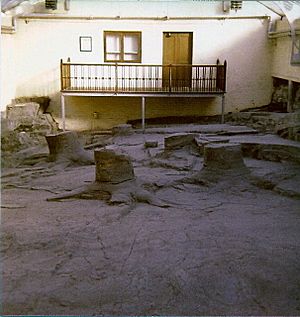Fossil Grove facts for kids
The Fossil Grove is a special place in Victoria Park, Glasgow, Scotland. It holds amazing plant fossils. These fossils were found in 1887. They are the ancient stumps and root systems of eleven extinct Lepidodendron plants. People sometimes call these "giant club mosses." They were like huge trees from a very long time ago.
Today, the Fossil Grove is a museum. It has been a popular place to visit since 1890. A building protects these ancient fossils from the weather. It lets you see what an old forest floor looked like.
Contents
What is the Fossil Grove?
The Fossil Grove covers an area about 23 meters long and 10 meters wide. It sits on the floor of an old stone quarry. The rocks around the fossils are about 325 million years old. These rocks show us what the Earth was like when these giant plants were alive.
About 290 million years ago, hot, melted rock pushed into the area. This rock, called dolerite, even went through two of the fossil tree trunks. Later, this dolerite rock was used to build roads nearby. The ancient plants were only found after the quarry was closed. Then, the area was turned into the beautiful Victoria Park.
What Kind of Plants are These Fossils?
The fossil stumps are like molds of the hollow insides of the ancient plants. They show the thick outer part of the plant, not the woody center. These stumps belonged to Lepidodendron veltheimianum plants. Their underground root systems are called Stigmaria. The most common type found here is Stigmaria ficoides.
Most of the fossil trunks are about 1 to 3 feet wide. They stand 2 to 3 feet tall. One larger stump in the west is about 3 to 4 feet wide. These trunks are still in the exact spots where they grew. Some fossils have small wrinkles, like old bark. The root-like parts spread out over 10 feet from the trunks. They branch out in a special way, typical of Stigmaria roots.
How Did These Ancient Plants Live?
The Lepidodendron plants grew during the Carboniferous period. Back then, Scotland was much warmer, almost like a tropical area near the equator. These giant plants lived in a low, swampy environment. This area would often flood. The way the trunks are spread out suggests the Grove was once part of a huge forest. This forest was mostly made up of Lepidodendron plants.
How Did the Fossils Form?
The sandstone at the Grove is covered with a layer of shale. This shale formed from mud left by a huge flood. This flood knocked over and killed the Lepidodendron plants. Over time, the soft parts of the plants rotted away. This made the stumps and roots hollow. Later floods filled these hollow spaces with sand.
You can see ripple marks on some surfaces. These marks show that the floodwaters flowed from the southwest. The sand inside the trunks turned into solid rock. The outer bark of the plants became a thin layer of coal. Some trunks are oval-shaped, especially the tallest one. This was likely caused by the strong floodwaters pushing on them. The oval shape points in the same direction as the ripple marks.
Besides the plant stumps, there are also signs of ancient worms. Their burrows are found in some of the sandstone layers.
History of the Fossil Grove
In 1885, land was set aside to create Victoria Park. The Fossil Grove was found in late 1887. Workers were digging a channel for a new road in the park. In April 1888, members of the Geological Society of Glasgow had a great idea. They suggested leaving the fossils where they were. They wanted to build a special building around them.
The local leaders agreed. In 1889, a building was constructed to protect the fossils. It cost about £400. On January 1, 1890, the Fossil House opened to the public. In the 1920s, the wooden roof supports were replaced with metal ones. During World War II, a bomb damaged the roof and one of the trunks. A concrete piece now fills the damaged part of the trunk. The glass roof was replaced with regular panels in the 1970s.
Today, Glasgow City Council still takes care of the building. Groups like the Fossil Grove Trust and Historic Scotland are working to make the site even better. They are improving drainage and making it easier to understand the fossils. Friends of Victoria Park are also creating a fern garden nearby. The fossil Lepidodendron plants are so important that they are a Site of Special Scientific Interest.
Visiting the Fossil Grove
As of August 2025, the Fossil Grove is open from 12:00 to 4:00 p.m. It opens only on the third Sunday of each month, from April to October. The park around it is always open. The Fossil House has paths and a few steps, and it is accessible for wheelchairs. A walk around the entire quarry is about 400 meters long. There is no charge to enter.
About 50 meters east of the Fossil House, you can see a cool oak sculpture. It shows a lycopod tree with a giant centipede. This sculpture was made in 2014. It celebrated the 20th Commonwealth Games held in Glasgow.
See also



